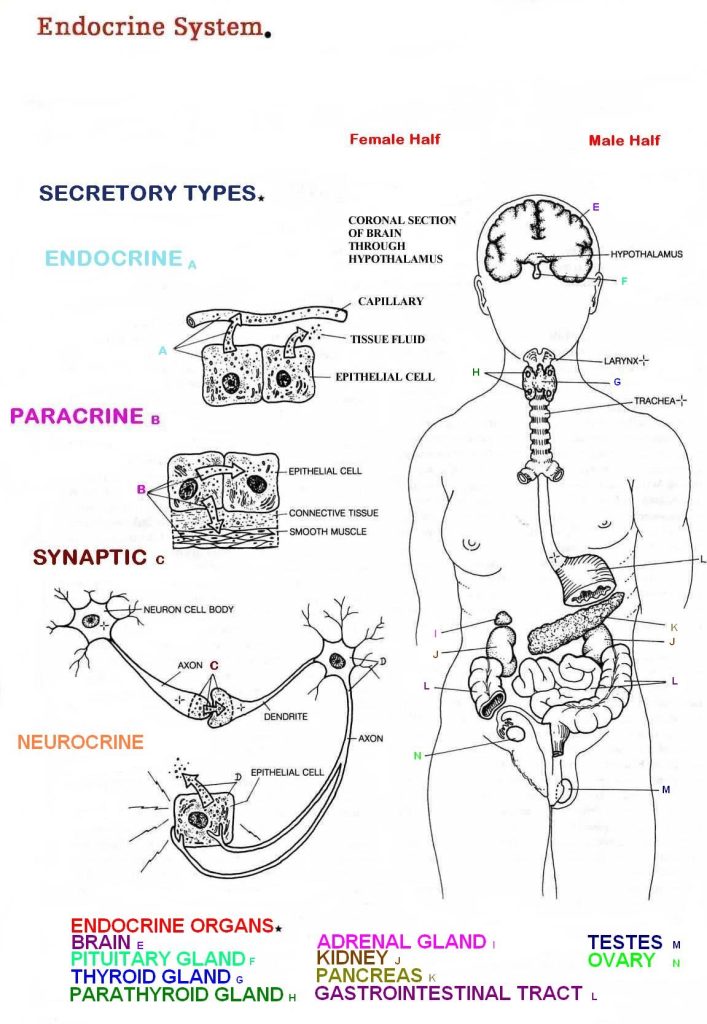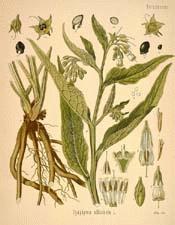The glandular system is made up of the hormone producing organs of the body, including the pituitary, thyroid, parathyroid, thymus, adrenal and pancreas. #
These glands perform a myriad of regulatory functions in the body, including temperature control and metabolic rate. Herbalists use herbs rich in trace minerals to supplement the production of hormones and enhance the efficiency of the glandular system.
A gland is an organ in the body that synthesizes a substance for release such as hormones or breast milk, often into the blood stream (endocrine gland) or into cavities inside the body or its out surface (exocrine gland). Glands can be divided into 2 groups: Endocrine glands and Exocrine glands.
—Endocrine gland— are glands that secrete their product directly onto a surface rather than through a duct.
—Exocrine glands— secrete their products via a duct; the glands in this group can be divided into three groups: Apocrine glands, Holocrine glands and Merocrine glands. The type of secretory product of an Exocrine gland may also be one of three categories: Serous gland, Mucous gland, Sebaceous glands.
—Apocrine glands— a portion of the secreting cell's body is lost during secretion. Apocrine gland is often used to refer to the apocrine sweat glands; however, it is thought that apocrine sweat glands may not be true apocrine glands as they may not use the apocrine method of secretion.
—Holocrine glands— the entire cell disintegrates to secrete its substances (e.g., sebaceous glands).
—Merocrine glands— cells secrete their substances by exocytosis (e.g., mucous and serous glands). Also called “eccrine”.
—Serous glands— secrete a watery, often protein-rich product.
—Mucous glands— secrete a viscous product, rich in carbohydrates (e.g., glycoproteins).
—Sebaceous glands— secrete a lipid product.
—Formation— Every gland is formed by an ingrowth from an epithelial surface. This ingrowth may from the beginning possess be a tubular structure, but in other instances glands may start as a solid column of cells which subsequently becomes tabulated.
As growth proceeds, the column of cells may divide or give off offshoots, in which case a compound gland is formed. In many glands the number of branches is limited, in others (salivary, pancreas) a very large structure is finally formed by repeated growth another, but in one instance, the liver, this does occur when a reticulated compound gland is produced. In compound glands the more typical or secretory epithelium is found forming the terminal portion of each branch, and the uniting portions form ducts and are lined with a less modified type of epithelial cell.
Glands are classified according to their shape.
If the gland retains its shape as a tube throughout it is termed a tubular gland.
In the second main variety of gland the secretory portion is enlarged, and the lumen variously increased in size. These are termed alveolar or saccular glands.
—Specific glands— Here are lists of human endocrine glands and human exocrine glands. #
Endocrine glands
1) Pineal gland
2) Pituitary gland
3) Thyroid gland
4) Thymus
5) Adrenal gland
6) Pancreas
7) Ovary
8) Testes
§ Exocrine glands
1) Sweat glands
2) Salivary glands
3) Mammary glands
4) Stomach
5) Liver
—Therapies for Relieving Excess— Blood sugar swings and metabolic fluctuations are examples of excess conditions of the glandular system. The hormone imbalances that disrupt the body's thermostat are also expressed as skin disorders.
Excess conditions in the glandular system are often marked by patterns of minor chest, pains and ailments including: backaches, abdominal cramps, an inability to gain weight, sore throats, itching skin, burning skin, burning urination, fear, anxiety, hyperactivity, fatigue, agitation, hot hands and feet, vertigo, fevers, thirst, dry skin, mouth sores, tinnitus, and dry coughs. I f left unchecked, these ailments may develop into illnesses including: hypoglycemia, hypothyroidism, hypertension, deafness, arthritis, autoimmune diseases, constipation, respiratory tract infections, dysmenorrhea, amenorrhea and menorrhagia.
These lists of empirical properties of an herb are the key to understanding herbal combinations. Herbalists have found that they can enhance a particular property of a single herb by adding herbs that complement and support a given property. Conversely, the herbalist is also able to minimize an unwanted property by adding herbs that counteract or balance that property.
—Therapies for Supplementing Deficient Conditions— Weakness in the glandular system is marked by serious conditions such as diabetes and Addison's disease as well as less serious and more common expressions of glandular deficiency such as hypothyroidism and obesity.
Deficient conditions of the glandular system are often associated with patterns of minor aches, pains, and ailments including: dry eyes, anemia, scanty menstruation, nail problems, muscle inflammation, frustration, depression, anger, fatigue, poor appetite, muscle spasms, obesity, inflammatory skin conditions, dry hair and insomnia. If left unchecked, these ailments may develop into illnesses including: Addison's disease, hypothyroidism, hepatitis, shingles, tumors, hemorrhoids, gallstones, deafness, dysmenorrhea, prostatitis, painful urination, premenstrual syndrome and menopausal distress.
These empirical lists of properties of an herb are the key to understanding herbal combinations. Herbalists have found that they can enhance a particular property of a single herb by adding herbs that complemented and supported that property. Conversely, the herbalist is also to minimize an unwanted property by adding herbs that counteract or balance the property.
—Reference— “Atlas of Human Anatomy” By – TAJ Books LTD; ISBN: 1-902328-40-X; Copyright 2002
—Reference— “Encyclopedia of Natural Medicine” Revised 2nd Edition by – Michael Murray, N.D. and Joseph Pizzorno, N.D.; ISBN0-7915-1157-1; Copyright 1998
—Reference— “Gray's Anatomy” By – Henry Gray F.R.S. Drawings by H.V. Carter; ISBN-13: 978-1-5661-9822-6; ISBN-10: 1-5661-9822-4 Copyright 1995
—References— “Medical Herbalism” The Science and Practice of Herbal Medicine By – David Hoffmann, FNIMH, AHG; ISBN: 0-89281-749-6 Copyright 2003
—References— “Nutritional Herbology” A Reference Guide to Herbs By – Mark Pedersen; ISBN: 1-885653-07-7 Copyright 2008
—References— “Prescription for Nutritional Healing” Fourth Edition a practical A to Z reference to drug-free remedies using vitamins, minerals, herbs and food supplements By – Phyllis A. Balch, CNC; ISBN: 1-58333-236-7 Copyright 2006
—References—Wikipedia.org
—References—
—References—



| Note: Information and statements about the products on this site have not been evaluated by the Food and Drug Administration and are not intended to diagnose, treat, sure, or prevent any disease. You should not use the information contained herein for diagnosing or treating a health problem or disease, or prescribing any medication. If you have or suspect that you have a medical problem, promptly contact your health care provider. Send us an email |  |
Generated on February 28, 2009
Updated on October 14, 2009



